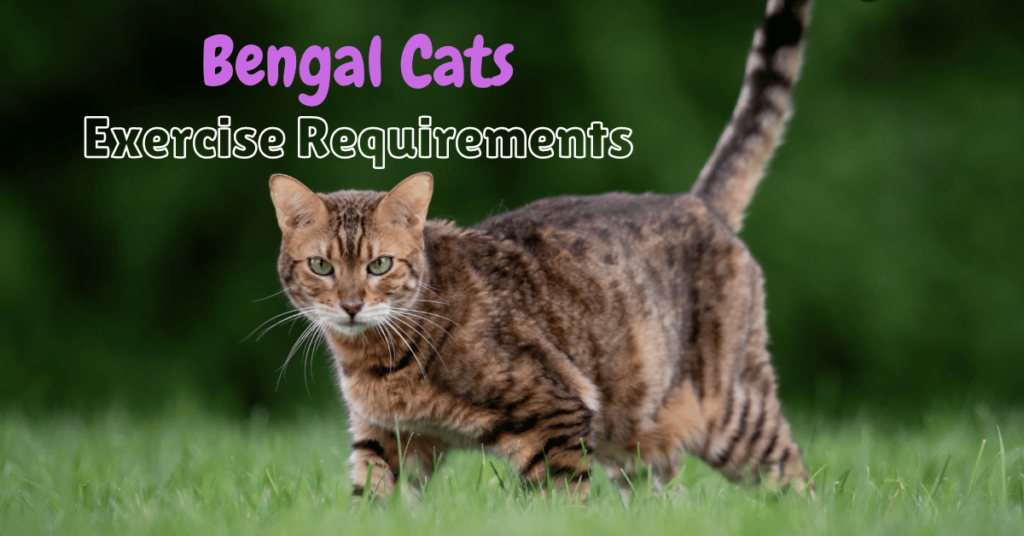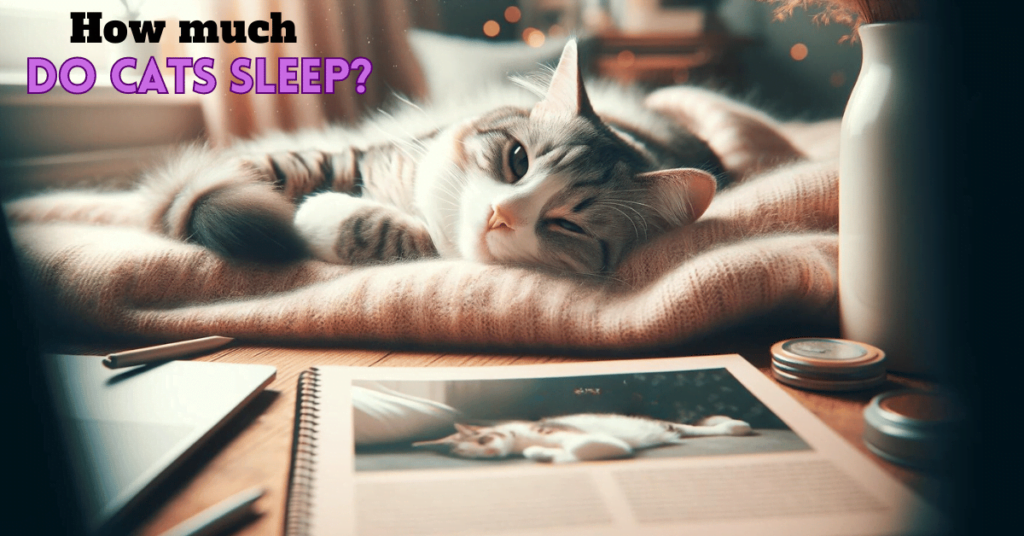This post contains affiliate links and I will be compensated if you make a purchase after clicking on my links.
Introduction: Cats On the Move
In the quest to keep our feline friends both agile and healthy, understanding their exercise needs is key. How much exercise do cats need to stay in purr-fect shape?
It’s a question that goes beyond the occasional game of catch-the-laser-pointer. While cat exercise wheels are a fantastic and innovative way to ramp up your cat’s daily activity, they’re just one part of the bigger picture of feline fitness.
In this exploration, we’ll delve into various fun and effective ways to achieve the ideal level of cat cardio – from high-tech wheels to simple, playful activities. Let’s unravel the secrets of keeping our cats not just entertained, but healthily active, as we navigate through different avenues of feline exercise that cater to every purr-sonality!
How Much Exercise Do Cats Need: Key Takeaways
If you’re looking for a quick scoop on keeping your cat fit and frisky, check out our key takeaway section below. But for the full purr-ticulars on feline fitness, keep reading and discover how to keep your cat’s tail wagging with health and happiness!
The Science of Feline Fitness: Regular exercise improves cats’ physical and mental health, controls weight, and reduces behavior issues.
How Much Exercise Do Cats Need?: Kittens require up to 1 hour of play daily; adult cats need 30-40 minutes; seniors benefit from 15-30 minutes. Exercise needs vary with age, breed, and health.
Innovative Cat Cardio Exercises: Include cat wheels, laser pointers, leash walks, bird feeders, catnip, clicker training, catios, puzzle toys, cat trees, and hide-and-seek games for varied stimulation.
Creating a Cat-Friendly Exercise Routine: Start slowly, maintain a consistent schedule, offer varied activities, use positive reinforcement, adapt to preferences, and balance exercise with rest.
Monitoring Your Cat’s Exercise: Track activity with tech tools and manual observation. Regular behavior and health check-ins help maintain an effective exercise routine.
The Science of Feline Fitness
In the symphony of feline well-being, exercise plays a leading role. It’s the rhythm that keeps their hearts healthy and their spirits high. This isn’t just about avoiding the extra pounds; it’s about nurturing their innate agility and keen minds.
The essence of Cat Cardio lies in maintaining that vibrant heartbeat and sprightly step. Regular movement helps control weight, keeping those sneaky, health-hindering issues like diabetes and heart disease at bay. But it’s not all about the physical; mental wellness dances along. An active cat is a content cat, free from the grips of boredom and anxiety.
Given their inherent need to prowl and explore, engaging their bodies and minds through exercise isn’t just beneficial – it’s essential.
And let’s not overlook a cat’s behavior – an orchestra in its own right. An active cat is a harmonious cat. Channeling their energy into playful ventures means less chance of a midnight serenade of meows or an impromptu claw concert on your sofa. It’s about tapping into their endless curiosity and zest for life.
How Much Exercise do Cats Need?
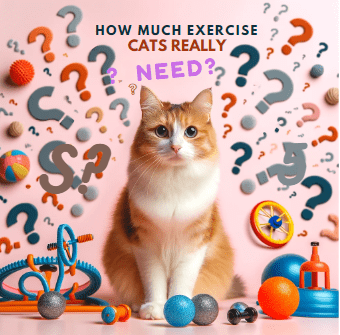
| Cat Category | Daily Exercise Time | Type of Exercise |
|---|---|---|
| Kittens and Young Cats | Up to 1 hour | Active play, interactive toys, training exercises |
| Adult Cats | 30 to 40 minutes | Mix of independent and interactive play |
| Senior Cats | 15 to 30 minutes | Gentle play, light interactive activities |
| Active Breeds (e.g., Siamese, Bengal) | More than 60 minutes | Vigorous and stimulating activities |
| Less Active Breeds | Varies, often lower | Gentle, less intense activities |
| Cats with Health Issues | Customized as per vet | Tailored to health needs and comfort level |
The amount and type of exercise a cat needs can vary widely, influenced by factors like age, breed, and overall health.
1. The Energetic Kittens
- Playtime Protocol: Up to 1 hour/day in short bursts.
- Activities: Interactive toys, chase-the-laser games, mind-stimulating training exercises.
They typically require more active playtime – up to an hour a day, divided into shorter sessions. This can include interactive toys, chasing games, or even training exercises that stimulate both their bodies and minds.
2. The Prime-Time Adults
- Daily Dose: 30-40 minutes of mixed fun.
- Fun & Games: A blend of solo toy adventures, exploration missions, and play sessions with humans.
As cats mature into their adult years, their energy levels might plateau, but the need for regular exercise remains. Adult cats benefit from around 30 to 40 minutes of daily physical activity. This can be a mix of independent play with toys, exploration activities, and interactive sessions with their human companions.
3. The Graceful Seniors
- Gentle Moves: 15-30 minutes/day, customized for comfort.
- Senior Specials: Soft play, indoor mini-walks, light interactive games to keep muscles toned and joints flexible.
Senior cats, with their wisdom and grace, may not have the same zest for vigorous play, but they still need to stay active to maintain muscle tone and joint flexibility. Gentle, consistent exercise for about 15 to 30 minutes a day, tailored to their comfort level, is ideal. This might include gentle play, short walks inside the home, or light interactive activities.
4. Breed-Specific Vibes
- Active Breeds: Siamese, Bengal, and Abyssinian Cats – Engage them for at least 1 hour daily.
- Less Active Breeds: Like the Ragdoll, Ragamuffin, Persian, and British Shorthair, about 30 minutes of combined playtime daily could just be the purr-fect amount.
The reason behind the varied playtime recommendations for different cat breeds lies in their unique genetic traits and energy levels. Active breeds like the Siamese, Bengal, and Abyssinian are akin to sprinters in the feline world—they thrive on mental and physical challenges and possess boundless energy that needs an outlet. Without ample playtime, these cats can become bored and develop undesirable behaviors.
On the flip side, less active breeds such as the Ragdoll, Persian, and British Shorthair have naturally lower energy levels. They often prefer a more leisurely lifestyle, making about 30 minutes of gentle play sufficient to keep them engaged and healthy.
5. Health Check
- Special Care: Tailored exercise plans for pals with obesity, arthritis, or heart issues.
Health considerations are equally critical. Cats with health issues like obesity, arthritis, or heart problems need specially tailored exercise plans.
Innovative Cat Cardio Exercises
To help you out, here’s a list of innovative cat cardio exercises that blend fun with fitness. Each of these ideas is designed to engage your cat in various forms of exercise, ensuring they get their heart pumping and muscles moving!
- Cat Wheel: A centerpiece of feline fitness tech. The cat wheel offers a safe space for your cat to run and jump, providing an excellent cardio workout in the comfort of your home.

- Laser Pointers: These are not just toys; they’re mini workout tools. Laser pointers encourage your cat to chase and jump, offering a fabulous cardiovascular workout. It’s a classic way to get your cat moving, with a high-tech twist.
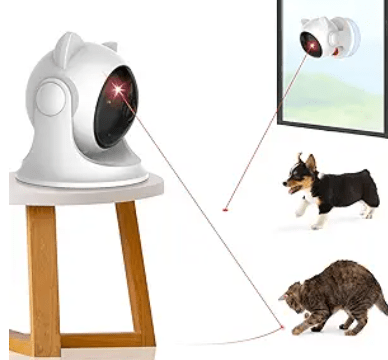
- Leash Training: Think beyond the backyard. Training and walking your cat on a leash lets them explore and stay active, combining adventure with exercise. It’s a great way to bond while boosting their health.
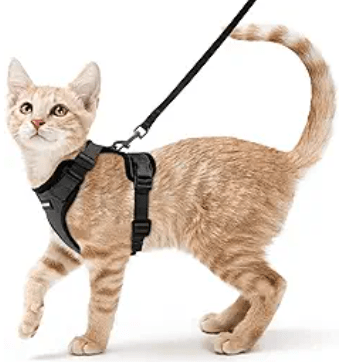
- Nature Friendly Environment: Transform a window into a feline cinema by placing your cat’s bed or perch near it. The view of birds at a feeder or fish in an aquarium is like a live nature show, captivating your cat’s attention and igniting their natural stalking and pouncing instincts. This setup provides a form of low-impact physical activity and enriching mental stimulation.
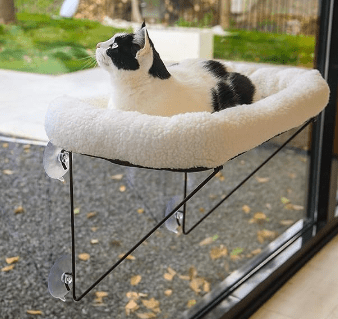
- Catnip: This natural herb is more than a treat; it’s a motivator. Catnip can inspire your cat to engage in playful antics, providing a fun way for them to exercise independently.
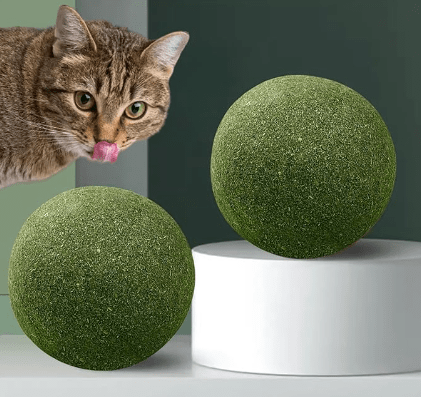
- Clicker Training: Who says cats can’t learn tricks? Clicker training involves teaching your cat various activities and obstacle courses, keeping them physically active and mentally sharp.
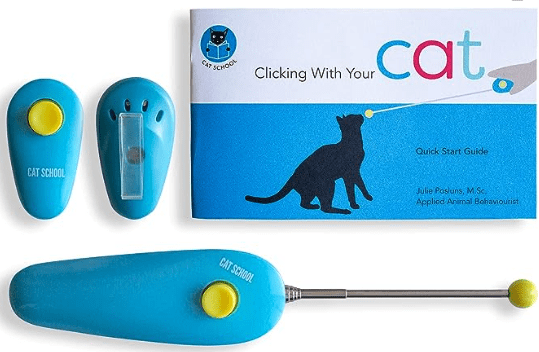
- Catios: These safe, enclosed outdoor spaces are perfect for the indoor adventurer. Catios allow your cat to enjoy fresh air and exercise in a controlled environment.

- Cat Puzzle Toys: Combine brain games with physical activity. These toys challenge your cat’s intellect and keep them moving, offering a holistic approach to exercise.

- Cat Trees: These are more than just resting spots; they’re fitness towers. Cat trees encourage climbing and stretching, giving your cat a full-body workout as they navigate the different levels.
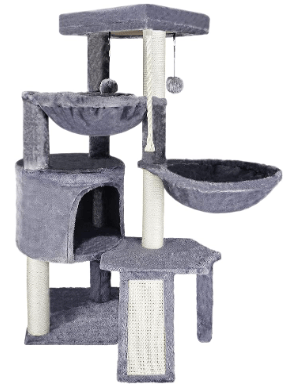
- Play Hide-and-Seek: Engage their hunting instincts. Hiding treats or toys around the house encourages your cat to explore and exercise, turning your home into an adventurous playground.
Creating a Cat-Friendly Exercise Routine
Embarking on a journey to create a cat-friendly exercise routine is like choreographing a dance – it’s about rhythm, consistency, and a touch of fun. Here’s how you can twirl exercise into your cat’s daily life, making it a delightful and engaging routine:
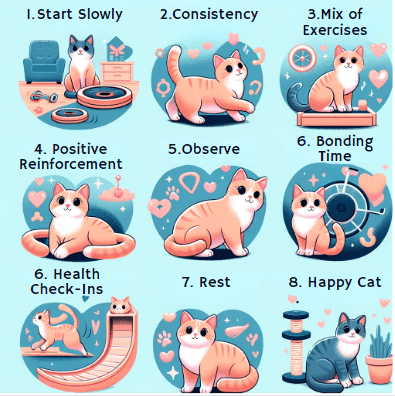
- Start Slowly: Imagine introducing the cat exercise wheel as the first step in a dance. It’s a gradual waltz, where your cat takes the lead. Let them explore and set the pace, with a dash of encouragement and a sprinkle of treats to guide their steps.
- Consistency is Key: Cats, much like their human counterparts, groove best with a steady beat. Establish specific times for exercise sessions – be it wheel running or playful frolics. This predictability is like a familiar tune, helping your cat anticipate and engage in the exercise dance.
- Mix It Up: To keep the rhythm exciting, vary the steps. Alternate between the exercise wheel, interactive toys, and manual play. This variety keeps your cat on their toes, ensuring a well-rounded and exhilarating exercise regime.
- Positive Reinforcement: After a dance well done, a reward is in order. Be it a treat, a loving stroke, or a cuddle, these affirmations turn exercise into a much-awaited encore.
- Observe and Adapt: Keep an eye on your cat’s reactions. If they favor certain activities, let those take center stage more often. Understanding their preferences is key to choreographing a sustainable and enjoyable exercise routine.
- Make it a Bonding Experience: Use exercise time to strengthen your duo. Playing together or cheering them on as they conquer the wheel can turn exercise into an eagerly awaited duet.
- Health Check-Ins: Regularly assess your cat’s fitness and well being. As they grow or their health tune changes, so should their exercise routine. Be ready to adapt the choreography to suit their evolving needs.
- Rest and Recovery: Every good dance routine includes moments of rest. Allow time for your cat to relax and recharge, ensuring they’re not overworked.
Incorporating these steps into your cat’s life creates a routine that transforms exercise into a delightful and anticipated part of their day.
Monitoring Your Cat’s Exercise
Monitoring your cat’s activity not only helps you understand their fitness levels but also cues you into their overall well-being. Let’s explore how to keep track of your cat’s exercise and why it’s crucial to stay attuned to their rhythmic changes.
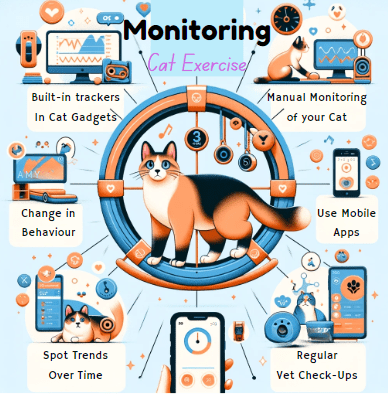
- Tech to the Rescue: In the age of gadgets and gizmos, tracking your cat’s exercise can be both fun and insightful. If you’ve introduced a cat exercise wheel, many come with built-in trackers that log running times and distances. It’s like having a fitness tracker for your furry friend, providing valuable data at your fingertips.
- Manual Monitoring: Not all monitoring needs to be high-tech. Observing your cat’s playtime and activity levels can be equally telling. How long do they engage in play? Are they showing enthusiasm for activities they previously enjoyed? These observations are key notes in understanding their exercise patterns.
- App Assistance: For the tech-savvy pet parent, numerous apps can help track your cat’s activity. From logging play sessions to monitoring outdoor adventures, these apps make it easy to keep a digital diary of your cat’s fitness journey.
- Behavioral Cues: Changes in your cat’s exercise habits can be subtle yet significant. A once playful cat turning lethargic or a normally lazy cat suddenly bursting with energy – these could be signs worth noting. It’s like watching for unexpected changes in a dance routine; they can indicate underlying issues or shifts in health.
- Consistency Counts: Regular check-ins on your cat’s exercise habits help you spot trends over time. Is there a gradual decrease in activity? Or perhaps an increase? These patterns are valuable insights, helping you adjust their routine for optimal health.
- Veterinary Input: Sometimes, the best monitoring comes from a professional. Regular vet checkups can provide a comprehensive picture of your cat’s health and fitness, ensuring their exercise routine aligns with their medical needs.
Conclusion
As we close the chapter on our feline fitness odyssey, understanding the right amount of exercise for our cats remains paramount. Whether it’s the spirited dash on the cat exercise wheel or the strategic pounce on a feather toy, every bit of activity is crucial for their well-being.
If you’re looking for a sprinkle of variety or perhaps an alternative that doesn’t involve the cat wheel, we’ve got you covered. Our guide on alternatives to cat exercise wheels dives into a myriad of engaging options to keep your cat active and entertained.
Meet Sean, a fintech whiz with a penchant for pet purrs and blockchain buzz. After a decade of fintech feats, Sean’s tech talents leaped from ledger lines to litter lines, driven by a passion for pets and a vision for a more connected pet care community. With three critter companions as co-pilots, Sean launched this blog to share a treasury of pet-friendly tech tips and tales.


